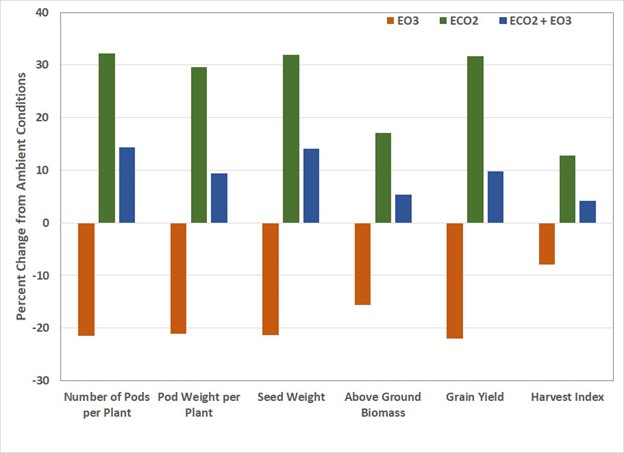CO2: Negating Ozone for Plant Productivity
By Craig D. Idso -- June 28, 2022The Individual and Combined Impacts of a Real Pollutant versus an Imagined One: How Elevated Ozone and Elevated CO2 Affect Chickpea Growth and Yield
Tropospheric ozone (O3) is a gaseous air pollutant that results from incomplete combustion of fossil fuels. It negatively affects plant growth, gaining entry through stomatal openings where it dismutates and generates reactive oxygen species that damage cell components and disturb metabolic processes.
In the United States alone, crop losses due to ozone pollution presently are estimated at $1-3 billion annually. But for much of the developing world, which lacks the pollution-control technologies employed by developed countries, the percent of ozone-related crop damage is much greater due to higher regional ambient or background levels of ozone pollution. And to make matters worse, ozone-related crop damage is expected to increase worldwide in the future, with ozone concentrations rising at a rate of 0.5 to 2 percent annually over the next century (IPCC, 2007).
However, the situation may not be as bad as it seems, especially when the positive effects of atmospheric CO2 enrichment on plant growth and yield are factored in, which typically reduce or fully negate plant cell damage from ozone.
A prime example of the end result of these two opposing forces (atmospheric CO2 enrichment and elevated tropospheric ozone) was recently reported by a team of researchers at the ICAR- Indian Agricultural Research Institute of New Delhi, India (Singh et al., 2021), who studied their individual and combined effects on chickpea (Cicer arietinum). Chickpea is a key pulse crop and significant source of protein for millions of persons in developing countries, accounting for approximately 15% of the global pulse production.
The experiment was conducted in the field under Free Air Ozone and Carbon Dioxide Enrichment where the chickpea plants were exposed to one of four treatments over the length of the growing season: ambient (400 ppm CO2 and 30 ppb O3), elevated O3 (400 ppm CO2 and 60 ppb O3), elevated CO2 (550 ppm CO2 and 30 ppb O3), or combined elevated CO2 and elevated O3 (550 ppm CO2 and 60 ppb O3). Key findings of the study are presented in Figure 1.

Figure 1. Percent change (relative to ambient conditions) in various growth and yield parameters of chickpea (Cicer arietinum) due to elevated ozone (EO3), elevated CO2 (ECO2) or combined elevated CO2 and elevated ozone (ECO2 + EO3) growing conditions. Source: Singh et al. (2021).
Not surprisingly, as shown above, elevated ozone concentrations significantly impacted a number of growth and yield-related parameters, reducing the number of pods per plant, pod weight per plant, seed weight, aboveground biomass, grain yield and harvest index from 6 to 22 percent (compared to ambient conditions). In contrast, elevated CO2 positively impacted each of these parameters, increasing them from 13 to 32 percent over that observed under ambient conditions.
But the real story, is what occurred in the combined elevated CO2 and elevated O3 treatment. Here, the positive growth-enhancing effects of atmospheric CO2 enrichment were strong enough to overpower the growth-retarding effects of ozone pollution, resulting in percentage increases in each of the measured parameters from 4 to 14 percent above ambient conditions. Consequently, the authors of this study conclude “the negative impacts of elevated O3 can be compensated by elevated CO2.”
Fortunately, the above findings are not unique to chickpea. A number of other studies have documented the ability of elevated CO2 to alleviate or overpower the growth-retarding influence of ozone pollution for a host of other plants (see the links on this page under the headings Ozone: Effects on Plants, Agricultural Species and Ozone: Effects on Plants, Tree Species). And oh how ironic this is — that an alleged pollutant (CO2), when paired with a real pollutant (O3), reduces or negates the harmful impacts of the real pollutant. It kind of makes one wonder what all the fuss over rising atmospheric CO2 is really about!
Notwithstanding current efforts to brand CO2 a pollutant, the science is clear. Rising levels of atmospheric CO2 will continue to positively impact the growth and yield of plants, including those areas of the globe that experience high levels of tropospheric ozone pollution, which areas may well shrink in size in the future as developing countries continue to modernize and improve their pollution control systems. And that is great news for the future food security of developing (and developed) nations!
References
IPCC. 2007. In: Solomon, S., Qin, D., Manning, M., Marquis, M., Averyt, K., Tignor, M.M.B., Miller, H.L., Chen, Z. (Eds.), Climate change 2007: the physical science basis. Contribution of Working Group I to the Third Assessment Report of the Intergovernmental Panel on Climate Change. Cambridge University Press, Cambridge UK.
Singh, R.N., Mukherjee, J., Sehgal, V.K., Krishnan, P., Das, D.K., Dhakar, R.K. and Bhatia, A. 2021. Interactive effect of elevated tropospheric ozone and carbon dioxide on radiation utilization, growth and yield of chickpea (Cicer arietinum L.). International Journal of Biometeorology 65: 1939-1952, doi.org/10.1007/s00484-021-02150-9.
Well written and researched. If we look back a few decades we can see another false standard that is applied. Ozone is fairly light yet the tailpipe emissions of it are demonstrated to remain close to the ground (not debating that, I have read enough on it). Why this counts, to preserve ownership of patents, a fake crisis was created where heavy gas (which collects low), without any method to explain transport was supposed to be magically transported to erode the ozone layer. Funny the weight difference is very significant between the 2, yet the only one studied for transport proved it stayed at surface level. This article once again proves that point. Thank you for being the voice of reason and science.